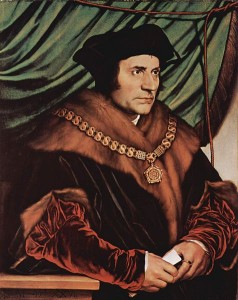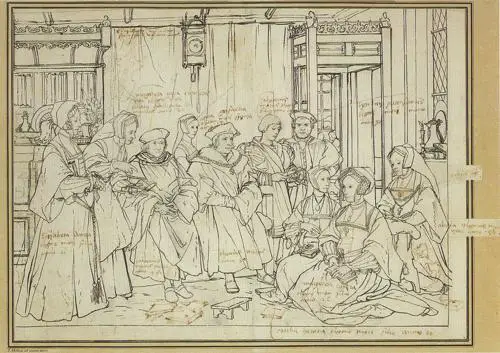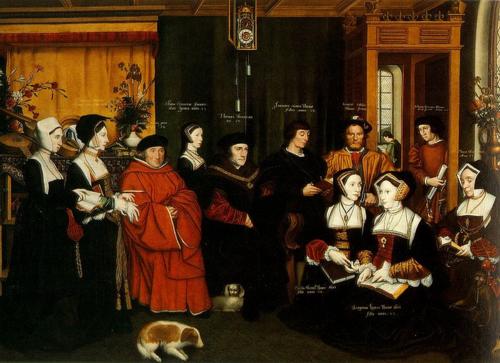
On this day in history, on the 7th February 1478, Sir Thomas More was born in Milk Street, London. He is famous as St Thomas More, after being beatified in 1886 and canonised in 1935, and his feast day is celebrated on the 22nd June in the Roman Catholic Church and the 6th July in the Anglican Church. He was executed on the 6th July 1535 during the reign of King Henry VIII.
As it is his birthday today, I thought I would write a factfile or bio on him.
Sir Thomas More Bio
Born: 7th February 1478 in Milk Street, London.
Died: 6th July 1535, executed at the Tower of London
Resting Place: Body buried in a common grave at St Peter ad Vincula Chapel, Tower of London, and head said to be buried in the Roper Vault at St Dunstan’s Church, Canterbury.
Family Background: Son of Sir John More (c.1451-1530), lawyer and judge on the King’s Bench, and Agnes Graunger (d.1499), daughter of Thomas Graunger, a Merchant of the Staple of Calais and an Alderman of London.
Education: Firstly St Anthony’s School, then from 1491 More joined the household of John Morton, Archbishop of Canterbury, then he studied at the University of Oxford. More studied Latin and logic before studying law in London.
Influences: Met and became friends with William Lilye, John Colet and Erasmus while at university.
Early Career: Between 1499 and 1503, More stayed at the Carthusian priory, London Charterhouse, while he considered joining the order. He also considered becoming a Franciscan monk but decided to devote himself to the law after he realised that a life of celibacy did not suit him. More became a Member of Parliament in 1504, an undersheriff of the City of London in 1510, a Master of Requests in 1514, one of the King’s counsellors in 1517 and then a Privy Counsellor in 1518.
Later Career: In 1521, Thomas More was knighted and made undertreasurer after proving himself by carrying out a diplomatic mission to Charles V with Cardinal Wolsey. He rose in influence as the King’s personal secretary and adviser, became Speaker of the House of Commons in 1523 and then the High Steward of the Universities of Oxford and Cambridge. He was appointed the Chancellor of the Duchy of Lancaster in 1525. In 1529, More was made Lord Chancellor after the fall of Cardinal Thomas Wolsey.
Scholarly Work: History of King Richard III (unfinished but written 1512-18 and said to have influenced William Shakespeare’s Richard III, Utopia (published in 1516) – an account of a fictional island society and its social, political and religious customs. The book contrasted the chaos of Europe with the ordered life in Utopia where there was religious toleration, communal ownership of land and education for all. Assertio Septem Sacramentorum (1521)- helped Henry VIII write this defence of the Catholic Church and the Seven Sacraments. Responsio ad Lutherum – A counter-response to Luther’s reply to the Assertio. Dialogue (1528) – A book against the writings of Tyndale. Confutation of Tyndale’s Answer (1532) – A six volume work in repy to Tyndale’s An Answer Unto Sir Thomas More’s Dialogue. A Dialogue of Comfort Against Tribulation (1534) – written while imprisoned in the Tower of London.
Spouse: First wife Jane (or Joanna/Joan) Colt (died in 1511). More immediately married Alice Middleton, a widow with money.
Children: More had four children by his first wife – 1) Margaret (Meg) More (1504-1544) who married William Roper in 1521 and had 5 children. 2) Elizabeth More (1506-1564) who married William Daunce in 1525 and had 7 children. 3) Cecily More (1507-?) who married Giles Heron in 1525 and had 3 children. 4) John More II (1509-1547) who married Anne Cresacre in 1529 and had eight children. Thomas More also raised Alice’s daughter from her first marriage as his own. Thomas More went againts convention and gave all of his daughters a top quality classical education.

Religious Views: Even though Thomas More decided that life as a monk did not suit him, he wore a hair shirt on a daily basis and was said to practise flagellation.
More and the Reformation: Sir Thomas More supported the Catholic Church, which he saw as the true faith, and campaigned against the Reformation and heresy. His actions against the Reformation included helping Cardinal Wolsey to prevent the importation of Lutheran books into England, producing scholarly works against Luther’s writings and persecuting people who he perceived as heretics.
Fall and Death: In 1530 Sir Thomas More refused to sign a letter asking the Pope to annul the marriage of Henry VIII and Catherine of Aragon. He offers his resignation in 1531 but the King refuses only to relent in 1532 when More claims that he is having chest pains and is ill – More does not agree with Henry VIII becoming the head of the church in England. In 1533, More did not attend the coronation of Anne Boleyn and this was seen as a snub and Henry VIII is forced to act against More. In summer 1533, Thomas Cromwell launches an investigation into More’s activities and in February 1534 More is linked with Elizabeth Barton, “the holy maid of Kent” and accused of conspiring with her against the King. More writes to the King and Cromwell pleading his case and affirming his loyalty to the King and manages to escape trial.
After refusing to take the Oath of Succession, promising to uphold the Act of Succession (which declared Henry’s marriage to Catherine of Aragon null and void and established a new line of succession through the King and Anne Boleyn), Sir Thomas More was arrested and imprisoned in the Tower of London on 17th April, 1534. Sir Thomas More was tried for high treason on 1st July 1535 and even though More believed that he could not be convicted because he had never spoken out against the King or denied his headship of the Church, Richard Rich (the Solicitor General) testified that More had, in his presence, denied that the King was head of the Church. It was also decided that More’s silence was evidence of “a corrupt and perverse nature”.
Sir Thomas More was found guilty under the Treason Act of 1534. Between the jury verdict and sentencing, Sir Thomas More took the opportunity to speak out and declared that “no temporal man may be the head of spirituality”. More was then sentenced to be hanged until “half dead”, then disemboweled and burned. A few days later, King Henry VIII commuted More’s sentence to death by beheading.
Here is an account of Sir Thomas More’s execution on the 6th July 1535 from A Complete Collection of State Trials and Proceeding Upon Impeachments for High Treason, etc (London, 1719), cited at http://www.law.umkc.edu/faculty/projects/FTrials/more/moretrialreport.html :-
“About Nine he was brought out of the Tower; his Beard was long, his face pale and thin, and carrying a Red Cross in his Hand, he often lift up his Eyes to Heaven; a Woman meeting him with a cup of Wine, he refused it saying, Christ at his Passion drank no wine, but Gall and Vinegar. Another Woman came crying and demanded some Papers she said she had left in his Hands, when he was Lord Chancellor, to whom he said, Good woman, have Patience but for an Hour and the King will rid me of the Care I have for those Papers, and every thing else. Another Woman followed him, crying, He had done her much Wrong when he was Lord Chancellor, to whom he said, I very well remember the Cause, and is I were to decide it now, I should make the same Decree.
When he came to the Scaffold, it seemed ready to fall, whereupon he said merrily to the Lieutenant, Pray, Sir, see me safe up; and as to my coming down, let me shift for myself. Being about to speak to the People, he was interrupted by the Sheriff, and thereupon he only desired the People to pray for him, and bear Witness he died in the Faith of the Catholic Church, a faithful Servant both to God and the King. Then kneeling, he repeated the Miserere Psalm with much Devotion; and, rising up the Executioner asked him Forgiveness. He kissed him, and said, Pick up thy Spirits, Man, and be not afraid to do thine Office; my Neck is very short, take heed therefore thou strike not awry for having thine Honesty. Laying his Head upon the Block, he bid the Executioner stay till he had put his Beard aside, for that had committed no Treason. Thus he suffered with much Cheerfulness; his Head was taken off at one Blow, and was placed upon London-Bridge, where, having continued for some Months, and being about to be thrown into the Thames to make room for others, his Daughter Margaret bought it, in closed it in a Leaden Box, and kept it for a Relique. Hall’s Chron. Vol. 2. S. 2.”
Legacy: Sir Thomas More was beatified in 1886 by Pope Leo XIII and then canonised along with John Fisher on the 19th May 1935 by Pope Pius XI. In 1970, More and Fisher were added to the Roman Catholic Calendar of Saints and given the 22nd June as their feast day. In 1980, Sir Thomas More and John Fisher were added to the Anglican Calendar of Saints and Heroes of the Christian Church and given 6th July as a celebratory day. In 2000, Pope John Paul II declared that Sir Thomas More was “the heavenly patron of statesmen and politicians.”
In The History of the English Speaking Countries Winston Churchill wrote of More:-
“The resistance of More and Fisher to the royal supremacy in Church government was a noble and heroic stand. They realised the defects of the existing Catholic system, but they hated and feared the aggressive nationalism which was destroying the unity of Christendom. … More stood as the defender of all that was finest in the medieval outlook. He represents to history its universality, its belief in spiritual values and its instinctive sense of other-worldliness. Henry VIII with cruel axe decapitated not only a wise and gifted counsellor, but a system, which, though it had failed to live up to its ideals in practice, had for long furnished mankind with its brightest dreams.”
and G.K. Chesterton wrote that More was the “greatest historical character in English history”.
Places: Institutions named after Sir Thomas More include The Thomas More Building at the Royal Courts of Justice at The Strand in London, The Thomas More Society: the politics society of Magdalen College, Oxford and the Thomas More Chambers in Lincoln’s Inn Fields, London.
Historic places associated with Sir Thomas More include: Westminster Hall at the Palace of Westminster, where there is a floor plaque commemorating More’s trial which took place in the original building; Crosby Hall, a privately owned reconstruction of More’s original Thames-side home; Chelsea Old Church whose southern chapel was commissioned by More and which contains the tomb and epitaph which More erected for himself and his wives; Tower Hill, Tower of London, where More was executed; St Peter ad Vincula Chapel, Tower of London, where More’s body was buried; St Dunstan’s Church Canterbury, which is home to the Roper vault where More’s daughter, Margaret Roper, buried More’s head; and Our Lady Queen of Martyrs and St Ignatius Catholic Church in Chideock, Dorset, which claims to have More’s hair shirt as a relic.

Saint Thomas More
In a moving article entitled “St Thomas More: A Man For This Season”, Deacon Keith Fournier quotes Pope John Paul II as saying of More:-
“Precisely because of the witness which he bore, even at the price of his life, to the primacy of truth over power, Saint Thomas More is venerated as an imperishable example of moral integrity. And even outside the Church, particularly among those with responsibility for the destinies of peoples, he is acknowledged as a source of inspiration for a political system which has as its supreme goal the service of the human person.”
and Fournier writes of how Sir Thomas More stood up for his faith and his beliefs:-
“This champion of heroic courage in the face of a State which has lost its soul never wavered in his fidelity to the Truth. He would not betray the truth or compromise it on the altar of public opinion or for political opportunism. He knew that to do so would not only have dishonored God and led his family and so many others astray, but that it would have given tacit assent to the emerging despotism of his age.
Thomas More was brought to trial for his fidelity to the Truth. Oh, as is always the case with persecution against Christians, it was framed as a charge against the “positive law”. There, this outstanding lawyer defended the Truth for which he would later give his life.”
Fournier then goes on to quote More himself, from an inscription in his Book of Hours:-
“Give me your grace, good Lord, to set the world at naught…to have my mind well united to you; to not depend on the changing opinions of others…so that I may think joyfully of the things of God and tenderly implore his help. So that I may lean on God’s strength and make an effort to love him… So as to thank Him ceaselessly for his benefits; so as to redeem the time I have wasted…”
Conclusion
Although I cannot agree with Sir Thomas More’s persecution of people he perceived to be heretics, I admire his courage, his unshakable faith, his honour and his desire to see a Utopian society. He knew what disagreeing with the King could lead to but he put his faith and his God first.
Sources
- “St Thomas More: A Man For This Season”
- Sir Thomas More Wikipedia Page
- “The Trial of Sir Thomas More Knight, Lord Chancellor of England, for High- Treason in denying; the King’s Supremacy, May 7, 1535. the 26th of Henry VIII”
- “The Family and Descendants of Sir Thomas More”
- “The Trial of Sir Thomas More: A Chronology”